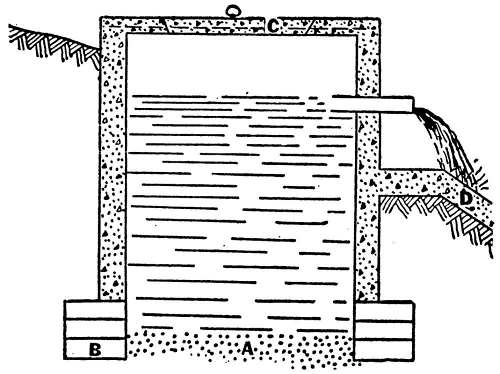The following information on water definitions and equivalents comes from Five Acres and Independence by M. G. Kains. Five Acres and Independence is also available to purchase in print.
Water Definitions and Equivalents
A gallon of water weighs 8.36 pounds and equals 231 cubic inches.
A cubic foot of water weighs 62.5 pounds and equals 7.48 gallons.
An “acre-inch” of water is the amount necessary to make a layer of water 1-inch deep on an acre (43,560 square feet). It requires 27,154 gallons to make an acre-inch of water.
“Pounds pressure” and “feet of head” are terms which indicate the pressure of a column of water. For instance, depth of water in a tank at sea level will create a specific amount of pressure which may be measured on a gauge at its base. Height above sea level causes variations due to pressure of the air; the greater the elevation, the less the pressure. Width or extent of tank is immaterial; the height of the water in the tank is what determines the pressure. As it increases the pressure increases; as it lessens the pressure lessens. Contrary to popular belief the supply pipe from a source lower than the tank should enter at the bottom, not over the top.
At sea level a column of water 2.3 feet high will produce 1 pound of pressure per square inch; a column 23 feet high will produce 10 pounds of pressure per square inch, no matter whether the tank be 1 foot or 100 feet in diameter.
To determine how large to build a tank or a cistern to supply the various needs of a farm the figures given in Table 1 will be found of great aid. See Chapter 14.

In order to main the purity and to protect the water of a spring from contamination, it is advisable to build a concrete tank. A, Sandy bottom. B, Substantial footing. C, Cover. D, Spillway. This last is one of the most important features of the construction because it prevents washing away of the soil and thus undermining the foundation. When such a tank is used for a gravity or a hydraulic ram system the outlet pipe should either enter through the footing or the side but its opening should be at least 4″ above the bottom, preferably pointing downward and certainly protected to prevent anything but water from gaining entrance. (See Chapter 14.)
Table 1
Water Consumption on the Farm
Water carried: 8 gals. per person per day.
Pump at kitchen sink: 10 gals. per person per day.
Faucet at kitchen sink: 12 gals. per person per day.
Running hot and cold water in kitchen: 18 gals. per person per day.
Complete plumbing with water under pressure: 30 gals. per person per day.
Bathtub*: 8-20 gals. each time used.
Closet*: 3-5 gals. each time used.
Lavatory (wash basin in bathroom): 1-2 gals. each time used.
Sprinkling lawn: 8 gals. per 100 square feet.
Soaking lawn: 20 gals. per 100 square feet.
Cow: 15 gals. per day.
Horse: 10 gals. per day.
Hog: 2 gals. per day.
Sheep: 1/2 gals. per day.
*Water for these purposes is included in the item above entitled “Complete Plumbing and Water under Pressure.”
